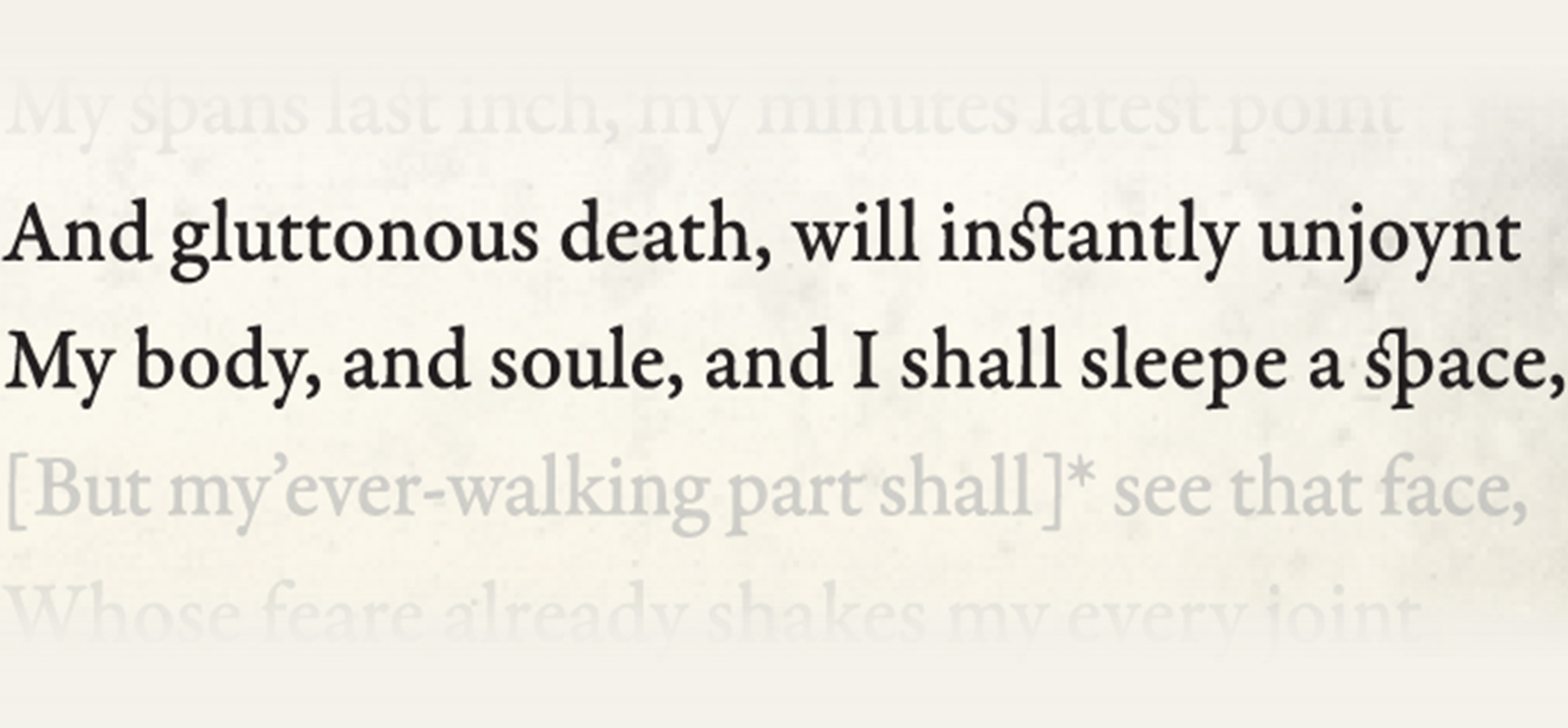
A fragment of Holy Sonnet 6, which demonstrates, Strier says, Donne’s confusion. (Graphic by Aaron Opie)
Does Donne dramatize religious incoherence or lapse into it?
This was how winter quarter began for the Divinity School’s long-running Wednesday Lunch lecture series: with English professor Richard Strier standing behind a podium in the Swift Hall common room while two dozen students and faculty polished off the last of their brownies and listened as he tore into John Donne’s Holy Sonnets. The title of Strier’s talk posed a question: “Does bad theology make for bad poetry?” The answer, he contended, was yes.
His fellow scholars were more than willing to argue the point.
Donne was born in 1572 into a devout Catholic family at a time when Catholicism was illegal in England. His mother was related distantly to Sir Thomas More, and his brother went to prison for sheltering Jesuits. But by the 1590s, he “seems to have become something of a religious skeptic, or perhaps more accurately, a religious seeker,” said Strier, the Frank L. Sulzberger distinguished service professor in the English department and the Divinity School, who has written articles analyzing Donne’s poetry and whose most recent book is The Unrepentant Renaissance: From Petrarch to Shakespeare to Milton (University of Chicago Press, 2011). “He spent a long period in religious suspension, reading the books of controversy on both sides of the great reformation debates, trying to figure out intellectually where he wanted to be.”
In the end, Donne emerged a Protestant and in 1615 became an Anglican priest. But Donne’s Holy Sonnets, now among his most celebrated poems, were written between 1607 and 1610, Strier said, before he’d fully aligned himself with his Protestant beliefs. And the theological confusion evident in some of the poems, Strier argued—with an almost gleeful vehemence that kept his audience chuckling—mars the poetry. Glancing periodically at his watch and wishing aloud that he had more time to speak (“this should be a three-hour seminar”), Strier analyzed three of Donne’s Holy Sonnets, including the most famous, which begins, “Batter my heart, three person’d God.” But the poem that seemed to dismay Strier most was sonnet number 6, describing the afterlife, with the opening line, “This is my playes last scene, here heavens appoint.” Reading to his listeners, who held printouts, Strier halted at the end of the sixth line: “and I shall sleepe a space.” “Well, well,” he said. “This raises the obvious question: he’s already identified his body and soul as separate entities. What is this ‘I’? Which one is it? Or is it neither? You see what I mean.”
Wading deeper into the poem, Strier teased out further religious confusion, including what he called Donne’s “weird ontological fantasy” about a postmortem stripping away of sins and a “really bizarre line” misconstruing the theological concept of “imputed righteousness”—bestowed on a sinner by faith alone—to the point of incoherence.
Div School dean Margaret Mitchell, AM’82, PhD’89, countered Strier’s criticism of Donne for using “I” without a clear sense of which self the “I” might refer to. “Did he introduce the theological confusion about Christian eschatology, or is it in fact inherent in the Christian tradition about as far back as we can go?” Mitchell asked. She could hear echoes, she said, of St. Paul’s words in Donne’s. “There is this tension between the immortality of the soul on the one hand, a sense of immediate postmortem survival,” she said, “and also this sense of eschatological resurrection—the body must be buried in the earth and then rise. So I actually thought the ‘I’ in line six is kind of skilled, because Donne has a Platonic dualism that you can read into if not find explicitly in Paul.”
Chiming in from his seat by the podium, Michael Murrin, a medieval and Renaissance literature scholar, reminded Strier of the turmoil during the early 17th century. “I would say one thing, Richard—and you know this too—between 1600 and 1610, people were moving all over the place in terms of their religious thinking.” He also accounted for Donne’s terror in the face of God, which Strier flagged as confused and wrong. Said Murrin, “And when he says he fears to see God”—here Murrin began chanting “Dies Irae,” a 13th-century Latin hymn about Judgment Day—“the Catholic background begins to appear, which he hasn’t always shaken off. I mean, the late-medieval idea of the end of the world is not, shall we say, as reassuring as we would like.”
“No, I think that’s right,” Strier answered Murrin, as the hour wound toward 1 p.m. and students began filing out of the room, dropping their utensils in a dishpan by the door and scraping their plates into a compost bin. “The fact that this is incoherent doesn’t mean that I want to make fun of it. I think Donne’s struggling, and I think the conceptions of what the state of being saved is like are so different from what he’s known.”
Clark Gilpin, AM’72, PhD’74, a former Div School dean who studies Christianity’s cultural history, asked about Donne wrestling with “questions of how to articulate a radical transformation,” from Catholicism to Protestantism. “Is there a preferred language of transformation that Donne finally arrives at, or is he constantly playing as a poet with different ways of articulating? Because if so, you might want to argue the reverse of your title: does bad poetry make for bad theology?”
Strier laughed. “I’m not sure how you’d argue that,” he said. A few minutes later, he left his audience with a final assessment of Donne: “There’s a difference between dramatizing incoherence and being incoherent,” he said. “In the better poems, he dramatizes it. In the worse ones, he just falls into it.”
